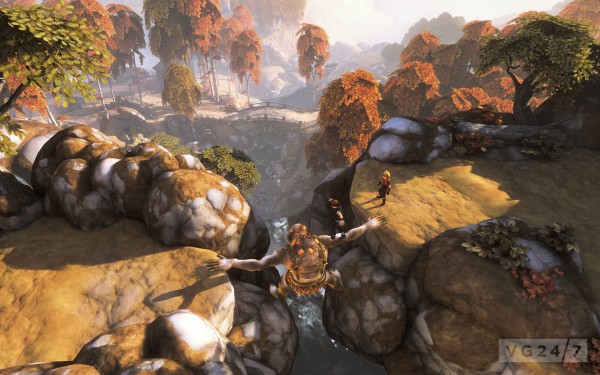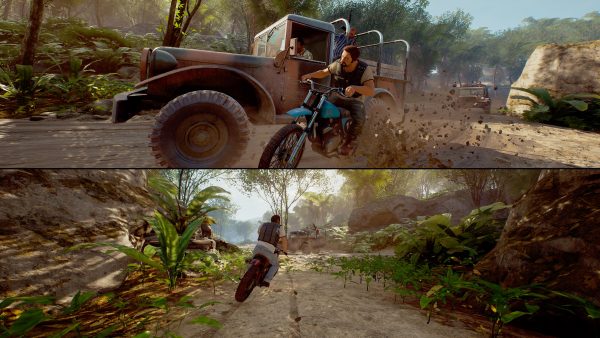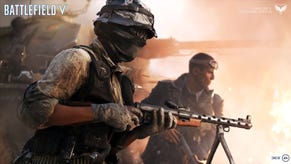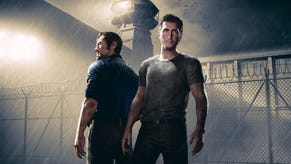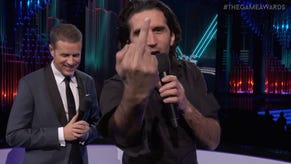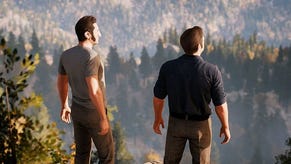Best of 2018: From a warzone to video game development - how life taught A Way Out director Josef Fares to “f**k s**t up”
It’s been a wild year for VG247, so to celebrate we’re going to be republishing some of our favourite work published in 2018 – opinion pieces, features, and interviews, that we’ve enjoyed writing and reading, and which we believe showcase some of our best work. Enjoy!
From a warzone to video game development – how life taught A Way Out director Josef Fares to “f**k s**t up” was first published on June 25, 2018.
This article contains spoilers for Brothers: A Tale of Two Sons and A Way Out.
F**k s**t up. That’s the motto of Hazelight, an indie studio headed up by Josef Fares, famous film director and infamous Game Awards guest.
When Fares speaks to his co-workers in the morning, he always reminds them of the studio’s ethos, nipping from desk to desk to remind everyone to f**k s**t up. When the team has meetings, they do it in a room in their new office - the room is labelled ‘F**k S**t Up’.
Fares didn’t get into video games to do things just like everyone else, he came to do the things he thought nobody else was doing. He came to f**k s**t up.
Fares grew up in a literal warzone: Lebanon at the height of the civil war. He was born in 1977 and didn’t emigrate to Sweden until he was ten years old.
“There was a civil war there, you know?” Fares tells me from his boardroom, his legs casually resting on the long meeting table. “It was a hard environment for a child. I don’t know how much detail we should go into, but it’s a country of war. You see a lot of stuff you shouldn’t see as a kid. You also experience some stuff a kid shouldn’t experience. A lot of violence. In a way, it’s formed me.”
"Coming into an apartment or a house where they don’t have a game console or computer of some kind, it’s kind of like coming into a place where they don’t have a toilet."
As a child, Fares escaped into creative outlets, drawing comics and playing games on his Atari - anything to keep busy, to retreat into another world.
“I think that was the start of my creative career,” he says. “You know when you’re young and you build something? Most of the kids kind of start it and then let it go. I always wanted to finish it. It was always me at the end.”
Video games are a medium he’s always adored. From Pong to The Last of Us, from Mario Galaxy 2 to Metal Gear Solid, Fares had many formative experiences with interactivity throughout his life.
“I can’t even describe how much I love them,” Fares explains. “I know some people work in this industry say, ‘Yeah, I don’t play so much’, and I’m like, ‘What?’. For me, coming into an apartment or a house where they don’t have a game console or computer of some kind, it’s kind of like coming into a place where they don’t have a toilet. I’m like, ‘What the f**k? How can you live here?’. That’s how weird it is.”
"I know for many people it’s important to say, ‘Yeah, he used to work for me, for that, and blah, blah, blah’ - all these bulls**t titles and stuff. I don’t care about that."
Just as video games and art formed his creative side, growing up in Lebanon during such a time of turmoil shaped his personality. He’s confident to the point of arrogance, but charming enough to offset it. It also helps that he has the track record to back up his hubris.
“I’ve always been humble towards life, humble towards people,” Fares says. “Even if I am a cocky personality, I would never treat someone with disrespect. Even silly details - at Hazelight, I never say, ‘he or she works for me’, it’s always ‘with me’. Hierarchy, especially when you believe in your own role, is always dangerous. I know for many people it’s important to say, ‘Yeah, he used to work for me, for that, and blah, blah, blah’ - all these bulls**t titles and stuff. I don’t care about that.”
During our chat, the one thing he does care about comes up a lot. He doesn’t give a s**t about consoles, he doesn’t care about the publishing side of things - though he does respect the financial side of the business - and he doesn’t care about money. But he does care about games. He wants to make new experiences and to leave his mark on what he sees as a fledgeling industry full of untapped potential.
Fares was previously a successful movie director in Sweden and Europe, and his last film, Balls, was a big box office hit. In 2006, Variety called Fares one of the top ten movie directors to watch, and he also won a the Nordic Council Film Prize for his semi-autobiographical film, Zozo, the same year. He still gets offers to direct films today.
“I just want to follow my passions,” he says. “With my last movie, I lost my passion for creating things. If you give me $100 million, it’s not going to work. I need to feel this urge, this passion. If I don’t feel that, I feel empty. Money doesn’t excite me.
“I want to take risks. I want to open every door, I want to try things that haven’t been tried. I want to do stuff. When people tell me ‘This is not going to work’, I’m like, ‘Interesting, we have something’.”
The thing driving him isn’t a will to prove naysayers wrong, however. He just wants to push the creative boundaries and video games are an outlet where he really can.
“I would argue that’s actually easy in games, to push the creative boundaries, right now,” the director explains. “In 50 years it will be way harder. We’re so early in how we understand how to make games, how to tell stories in games, or how to create emotions.”
If you have ever played Fares’ debut game, Brothers: A Tale of Two Sons, you will know his work speaks to this mindset. Here is a single-player game where you control two characters, one on each stick. Fares wanted you to experience a kind of symbiosis, where the brothers were an extension to one another. You share the physical connection they feel as siblings. Later in the game, one brother is killed and you have to learn to continue with that missing piece.
“It’s almost like you’re [playing co-op with] yourself,” Fares says. “You would feel that physical loss of the hand. It was important that it was [the left thumbstick], the big brother, [that died] - the hand you would normally use to control the character.
“That’s also a good example of how much creativity is left in games. I remember to talking to a friend of mine who doesn’t know anything about video games. He asked me why people were so excited for Brothers. I told him one of the reasons was because it has unique controls. I showed him the controller and was like, ‘You see this stick? You control one guy. With this stick, you control the other guy’. He was like, ‘What the f**k? How can that be unique, there are two sticks’. I do think it’s very obvious and I do think we’ve just scratched the surface on how we make games. It’s an exciting time. I’m not saying everything has to be unique, I just feel like there’s still a lot to see.”
Of course, this entire thing has been a learning experience for Fares. When he first came into games, he didn’t understand code at all. He didn’t understand all the restrictions that can hamper creativity. For example, at one point during planning for Brothers, Fares wanted to create a boss fight with a giant snake.
"You also experience some stuff a kid shouldn’t experience. A lot of violence. In a way, it’s formed me."
Slithering through the long grass, players needed to sync up the brothers with a net and capture the creature. The people coding the game looked at Fares in disbelief - this sequence would have been incredibly complex due to all the physics interactions.
“I mean, this was 2011, so maybe now it’s easier to do,” Fares says. “Everything is possible in games, but do you want to spend two years on a mechanic or a short boss sequence? We will lose other stuff.”
As an indie studio, Hazelight doesn’t have the luxury of prototyping things for too long. Take Horizon: Zero Dawn - Guerilla spent over a year just getting the largest dinosaur to work, with all its removable parts and complex behaviours. Not everyone has the resources of a first-party Sony studio, and you have to work with what funds are available. And so the snake was kicked into the long grass.
“I have many crazy ideas and I still have it today,” Fares admits. “Some developers say, ‘No, that’s not possible’, and I say, ‘Why not?’. I keep pushing it. The one thing that frustrates me in game development a little bit, is you work in a movie set and you come across similar things - you say to the art director, ‘Let’s do this’, and the art director might say it’s impossible. But because I know what it’s about, I can tell them to do this, this, and this, and suddenly it is possible. I can’t do that in game development because I don’t understand code, so I don’t know what’s possible from that perspective. But for every year I work in this industry I understand more, so I can make people push.”
"I would argue that’s actually easy in games, to push the creative boundaries, right now."
Hazelight’s most recent game, A Way Out comes from that same place - a willingness to do something different. A Way Out is a narrative game that you can only play in co-op. You can not play that game at all if you can’t get someone to play it with you, which is why Hazelight made sure a friend could download and play it with you online if you only had a single copy between you. The reason it is co-op only is because of the payoff - an ending that subverts expectations built up over years of video game familiarity.
“I love to tell stories and I want to find new ways to tell stories,” Fares explains. “When we experience a movie, we experience stories together. It comes naturally when you have a co-op story. Also, when you have more than one character you can make more dynamic and dramatic situations. I’ve been getting a lot of comments saying, ‘I hate you, Josef Fares, you made me cry’. I’ve also had people saying it’s the worst game ending ever. It’s a compliment.
“When they hate the ending, I love it. Not everybody got it. Some people got upset. When people get upset and angry, that kind of makes me happy. When someone calls A Way Out the worst ending ever, I take it as a huge compliment. It’s polarising, but the reaction has been super strong.”
If you haven’t played it, you’re probably wondering what it is that’s so polarising about the ending of this indie co-op game. During the final act, the story reveals that one player was an undercover cop the whole time - A Way Out suddenly turns into a versus game. One of you chases the other in a helicopter, firing at them from the side door as they speed off in a boat. This is followed by two separate shootouts, and a final, cinematic QTE where the winner of the previous three sections get an advantage. Hours before, you are playing Connect Four in a hospital waiting room, or competing to do wheelies on a wheelchair.
“The good thing with telling a story in games is the interactivity,” Fares says. “You’re way more a part of the story than with a movie. I love how you can affect two people. I mean, all the minigames - everything in A Way Out was there to bond the players together, to really tear them apart at the end. I really love the dynamic for telling a story for two players at the same time. We see the minigames as part of the story, because people stop and have fun, they play, they laugh together.”
"When someone calls A Way Out the worst ending ever, I take it as a huge compliment."
With A Way Out, Fares wasn’t just thinking about what happened on the screen. All the minigames and seemingly incidental details were there to make the players sat on the couch chat and bond over the game. This was all done to make the ending feel more impactful. Like that lost limb in Brothers.
A Way Out is stuffed with variety - there are car chases, puzzles, shootouts, stealth sections, minigames, and even a Streets of Rage-esque corridor fight. At one point, there was going to be even more. Rather than resolving the end of the game with multiple shootouts, the original idea was to make a 2D fighter for the final scene.
“We tried four iterations, if not even more,” Fares remembers. “Like an actual, almost Street Fighter fight. But we already had problems with people expecting triple-A [quality]. Because if you play a shooter, the shooting should be really good, like Tomb Raider or Uncharted. Doing a Street Fighter game, for that particular reason, was very hard. It really didn’t feel good at all so we had to take it away.”
In fact, that was one of the biggest challenges with making A Way Out in the first place. With so much variety, all the various parts had no chance of living up to the best games in their respective genres. Fares hoped players could see past that, however.
“We had one coder working on the third-person shooting, so of course… if we were Naughty Dog, with their team skills, we would have done it way better,” Fares says. “But normally it costs a lot of money to make a mechanic. I’d rather have less polished mechanics and variation than way polished mechanics and doing the same thing over and over. I get tired of repetition.
“I know some people complained about the shooting but, at the same time, it’s not a shooter. It’s something you do for a short while, then you don’t do it again. We were compared to the shooting in Uncharted 4 - it doesn’t feel as good as that. I’m like, ‘Okay’. They have extremely way more money and people working on the core mechanic, and they have four or five games behind that. They have systems, animation systems - it would be silly to think we could come close to that. It’s not possible.”
Because it was being published by EA, the expectations of players was a little skewed. Many didn’t see A Way Out as an indie game at all, in fact, which probably wasn’t helped by its ambition.
"We have a short time in this life. Make sure to f**k s**t up, but always treat the people around you with respect."
“A Way Out was such an ambitious game with such a small team,” Fares says. “Just the online thing - a year before release we were like ‘f**k’. If you played online, everything looked like s**t. You were flying around. I was this close to saying, ‘F**k online, let’s just release it’.”
Luckily, the studio got past it, A Way Out was released, and well over two million people have experienced it. Coming off the back of that success and working from a swanky new office, Hazelight is busy working on the next game and Fares has put A Way Out to the back of his mind, solely focused on the next idea. Exactly what it will be is anyone’s guess, but Fares says he thinks people will identify it as a Hazelight game.
While you wait for that, I’ll leave you with some wise words from the man himself: “We have a short time in this life. Make sure to f**k s**t up, but always treat the people around you with respect.”




